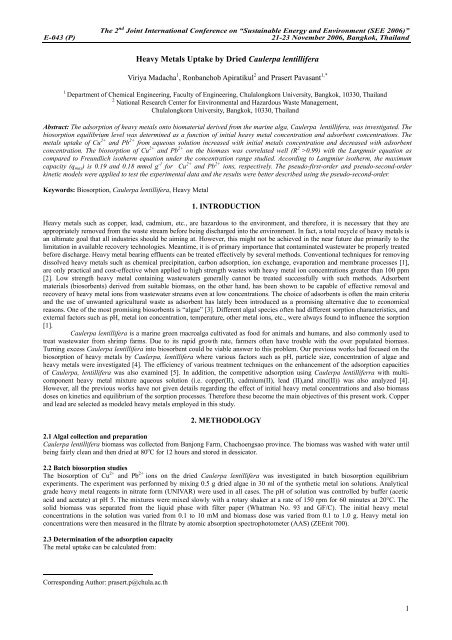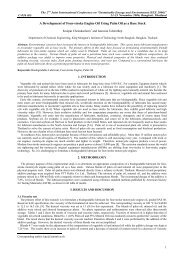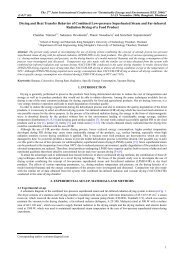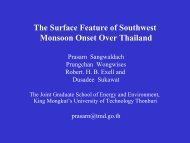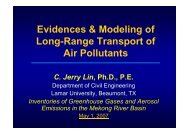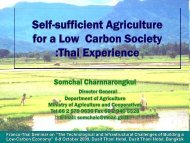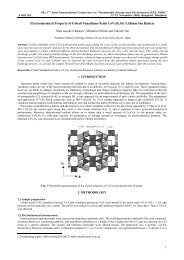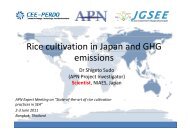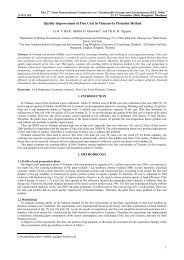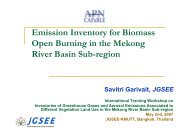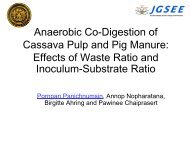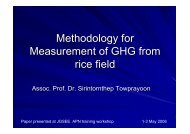Heavy Metals Uptake by Dried Caulerpa lentillifera - The Joint ...
Heavy Metals Uptake by Dried Caulerpa lentillifera - The Joint ...
Heavy Metals Uptake by Dried Caulerpa lentillifera - The Joint ...
You also want an ePaper? Increase the reach of your titles
YUMPU automatically turns print PDFs into web optimized ePapers that Google loves.
<strong>The</strong> 2 nd <strong>Joint</strong> International Conference on “Sustainable Energy and Environment (SEE 2006)”<br />
E-043 (P) 21-23 November 2006, Bangkok, Thailand<br />
1. INTRODUCTION<br />
<strong>Heavy</strong> metals such as copper, lead, cadmium, etc., are hazardous to the environment, and therefore, it is necessary that they are<br />
appropriately removed from the waste stream before being discharged into the environment. In fact, a total recycle of heavy metals is<br />
an ultimate goal that all industries should be aiming at. However, this might not be achieved in the near future due primarily to the<br />
limitation in available recovery technologies. Meantime, it is of primary importance that contaminated wastewater be properly treated<br />
before discharge. <strong>Heavy</strong> metal bearing effluents can be treated effectively <strong>by</strong> several methods. Conventional techniques for removing<br />
dissolved heavy metals such as chemical precipitation, carbon adsorption, ion exchange, evaporation and membrane processes [1],<br />
are only practical and cost-effective when applied to high strength wastes with heavy metal ion concentrations greater than 100 ppm<br />
[2]. Low strength heavy metal containing wastewaters generally cannot be treated successfully with such methods. Adsorbent<br />
materials (biosorbents) derived from suitable biomass, on the other hand, has been shown to be capable of effective removal and<br />
recovery of heavy metal ions from wastewater streams even at low concentrations. <strong>The</strong> choice of adsorbents is often the main criteria<br />
and the use of unwanted agricultural waste as adsorbent has lately been introduced as a promising alternative due to economical<br />
reasons. One of the most promising biosorbents is “algae” [3]. Different algal species often had different sorption characteristics, and<br />
external factors such as pH, metal ion concentration, temperature, other metal ions, etc., were always found to influence the sorption<br />
[1].<br />
<strong>Caulerpa</strong> <strong>lentillifera</strong> is a marine green macroalga cultivated as food for animals and humans, and also commonly used to<br />
treat wastewater from shrimp farms. Due to its rapid growth rate, farmers often have trouble with the over populated biomass.<br />
Turning excess <strong>Caulerpa</strong> <strong>lentillifera</strong> into biosorbent could be viable answer to this problem. Our previous works had focused on the<br />
biosorption of heavy metals <strong>by</strong> <strong>Caulerpa</strong>, <strong>lentillifera</strong> where various factors such as pH, particle size, concentration of algae and<br />
heavy metals were investigated [4]. <strong>The</strong> efficiency of various treatment techniques on the enhancement of the adsorption capacities<br />
of <strong>Caulerpa</strong>, <strong>lentillifera</strong> was also examined [5]. In addition, the competitive adsorption using <strong>Caulerpa</strong> lentilliferra with multicomponent<br />
heavy metal mixture aqueous solution (i.e. copper(II), cadmium(II), lead (II),and zinc(II)) was also analyzed [4].<br />
However, all the previous works have not given details regarding the effect of initial heavy metal concentrations and also biomass<br />
doses on kinetics and equilibrium of the sorption processes. <strong>The</strong>refore these become the main objectives of this present work. Copper<br />
and lead are selected as modeled heavy metals employed in this study.<br />
2. METHODOLOGY<br />
2.1 Algal collection and preparation<br />
<strong>Caulerpa</strong> <strong>lentillifera</strong> biomass was collected from Banjong Farm, Chachoengsao province. <strong>The</strong> biomass was washed with water until<br />
being fairly clean and then dried at 80 o C for 12 hours and stored in dessicator.<br />
2.2 Batch biosorption studies<br />
<strong>The</strong> biosorption of Cu 2+ and Pb 2+ ions on the dried <strong>Caulerpa</strong> <strong>lentillifera</strong> was investigated in batch biosorption equilibrium<br />
experiments. <strong>The</strong> experiment was performed <strong>by</strong> mixing 0.5 g dried algae in 30 ml of the synthetic metal ion solutions. Analytical<br />
grade heavy metal reagents in nitrate form (UNIVAR) were used in all cases. <strong>The</strong> pH of solution was controlled <strong>by</strong> buffer (acetic<br />
acid and acetate) at pH 5. <strong>The</strong> mixtures were mixed slowly with a rotary shaker at a rate of 150 rpm for 60 minutes at 20°C. <strong>The</strong><br />
solid biomass was separated from the liquid phase with filter paper (Whatman No. 93 and GF/C). <strong>The</strong> initial heavy metal<br />
concentrations in the solution was varied from 0.1 to 10 mM and biomass dose was varied from 0.1 to 1.0 g. <strong>Heavy</strong> metal ion<br />
concentrations were then measured in the filtrate <strong>by</strong> atomic absorption spectrophotometer (AAS) (ZEEnit 700).<br />
2.3 Determination of the adsorption capacity<br />
<strong>The</strong> metal uptake can be calculated from:<br />
<strong>Heavy</strong> <strong>Metals</strong> <strong>Uptake</strong> <strong>by</strong> <strong>Dried</strong> <strong>Caulerpa</strong> <strong>lentillifera</strong><br />
Viriya Madacha 1 , Ronbanchob Apiratikul 2 and Prasert Pavasant 1,*<br />
1<br />
Department of Chemical Engineering, Faculty of Engineering, Chulalongkorn University, Bangkok, 10330, Thailand<br />
2 National Research Center for Environmental and Hazardous Waste Management,<br />
Chulalongkorn University, Bangkok, 10330, Thailand<br />
Abstract: <strong>The</strong> adsorption of heavy metals onto biomaterial derived from the marine alga, <strong>Caulerpa</strong> <strong>lentillifera</strong>, was investigated. <strong>The</strong><br />
biosorption equilibrium level was determined as a function of initial heavy metal concentration and adsorbent concentrations. <strong>The</strong><br />
metals uptake of Cu 2+ and Pb 2+ from aqueous solution increased with initial metals concentration and decreased with adsorbent<br />
concentration. <strong>The</strong> biosorption of Cu 2+ and Pb 2+ on the biomass was correlated well (R 2 >0.99) with the Langmuir equation as<br />
compared to Freundlich isotherm equation under the concentration range studied. According to Langmiur isotherm, the maximum<br />
capacity (q max ) is 0.19 and 0.18 mmol g -1 for Cu 2+ and Pb 2+ ions, respectively. <strong>The</strong> pseudo-first-order and pseudo-second-order<br />
kinetic models were applied to test the experimental data and the results were better described using the pseudo-second-order.<br />
Keywords: Biosorption, <strong>Caulerpa</strong> <strong>lentillifera</strong>, <strong>Heavy</strong> Metal<br />
Corresponding Author: prasert.p@chula.ac.th<br />
1
<strong>The</strong> 2 nd <strong>Joint</strong> International Conference on “Sustainable Energy and Environment (SEE 2006)”<br />
E-043 (P) 21-23 November 2006, Bangkok, Thailand<br />
V ( Ci − C<br />
f<br />
)<br />
q = (1)<br />
m<br />
where q is amount of metal uptake per unit mass of biomass (mol kg -1 ), C i is initial concentration of heavy metal (mol m -3 ), C f is<br />
final concentration of heavy metal (mol m -3 ), V is volume of the solution (m 3 ), m is dry mass of the algae (kg).<br />
3. RESULTS AND DISCUSSION<br />
3.1 Effect of initial metal concentration on biosorption<br />
Initial metal concentration was found to have significant effect on the biosorption capacities of caulerpa <strong>lentillifera</strong>. Figs 1 and 2<br />
illustrate the variation in the sorption capacity (q) as a function of initial heavy metal concentrations between 0.1 and 10 mM where it<br />
was found that a higher initial concentration provided a higher sorption capacity. This was because the initial metal ion concentration<br />
provides an important driving force to overcome all mass transfer resistances of Cu 2+ and Pb 2+ between the aqueous and solid phases<br />
[6]. This is the fundamental of the equilibrium between the sorption capacity and the final heavy metal concentration in the liquid<br />
phase, and this equilibrium is a very important factor that limits the sorption process.<br />
q (mmol g -1 )<br />
0.16<br />
0.14<br />
0.12<br />
0.1<br />
0.08<br />
0.06<br />
Cu 0.1 mM<br />
Cu 0.2 mM<br />
Cu 0.3 mM<br />
Cu 0.8 mM<br />
Cu 1 mM<br />
Cu 3 mM<br />
Cu 5 mM<br />
Cu 10 mM<br />
0.04<br />
0.02<br />
0<br />
0 10 20 30 40 50 60 70<br />
time (min)<br />
Fig. 1 Effect of initial Cu 2+ ions concentration on biosorption <strong>by</strong> caulerpa <strong>lentillifera</strong> (pH 5, agitation speed: 150 rpm, temperature<br />
20 o C adsorbent dose 0.5 g)<br />
q (mmol g -1 )<br />
0.16<br />
0.14<br />
0.12<br />
0.1<br />
0.08<br />
0.06<br />
0.04<br />
0.02<br />
0<br />
Pb 0.1 mM<br />
Pb 0.2 mM<br />
Pb 0.3 mM<br />
Pb 0.8 mM<br />
Pb 1.0 mM<br />
Pb 3.0 mM<br />
Pb 5.0 mM<br />
Pb 10 mM<br />
0 10 20 30 40 50 60 70<br />
time (min)<br />
Fig. 2 Effect of initial Pb 2+ ions concentration on biosorption <strong>by</strong> caulerpa <strong>lentillifera</strong> (pH 5, agitation speed: 150 rpm, temperature<br />
20 o C adsorbent dose 0.5 g)<br />
3.2 Effect of adsorbent dose on biosorption<br />
<strong>The</strong> effects of adsorbent concentration on the removal of heavy metal ions from aqueous were investigated using three different<br />
adsorbent concentrations. <strong>The</strong> extent of biosorption is proportional of specific area which is defined as the portion of the area<br />
available for biosorption to the total area on the sorbent [6]. Adsorbent concentration was varied from 0.1 to 1g/30 mL of synthetic<br />
2
<strong>The</strong> 2 nd <strong>Joint</strong> International Conference on “Sustainable Energy and Environment (SEE 2006)”<br />
E-043 (P) 21-23 November 2006, Bangkok, Thailand<br />
waste water. <strong>The</strong> effect of biomass on the sorption kinetics of heavy metal ion was studied at pH of 5.0 and 0.1 mM initial Cu 2+ and<br />
Pb 2+ concentrations. <strong>The</strong> results for the adsorption of Cu 2+ and Pb 2+ are presented in Figs. 3 and 4, respectively, which indicated that<br />
the equilibrium concentrations for both metals decreased with increasing biomass doses for a given initial Cu 2+ and Pb 2+<br />
concentration. This result was anticipated because increasing adsorbent doses provided a greater surface area which could<br />
accommodate a higher quantity of heavy metals, and due to the equilibrium limitation, the quantity of metals being adsorbed for a<br />
certain unit surface area of adsorbent decreased [7,8].<br />
0.008<br />
0.007<br />
0.006<br />
q (mmol g -1 )<br />
0.005<br />
0.004<br />
0.003<br />
0.002<br />
0.001<br />
0<br />
0.1 g/30 ml of synthetic solution<br />
0.25 g/30 ml of synthetic solution<br />
0.5 g/30 ml of synthetic solution<br />
1.0 g/30 ml of synthetic solution<br />
0 10 20 30 40 50 60 70<br />
time (min)<br />
Fig. 3 Effect of adsorbent dose on Cu 2+ biosorption <strong>by</strong> caulerpa <strong>lentillifera</strong> (pH 5, agitation speed: 150 rpm, temperature 20 o C initial<br />
Cu 2+ concentration 0.1 mM)<br />
0.018<br />
0.016<br />
q (mmol g -1 )<br />
0.014<br />
0.012<br />
0.01<br />
0.008<br />
0.006<br />
0.1g/30 ml of synthetic solution<br />
0.25g/30 ml of synthetic solution<br />
0.5g/30 ml of synthetic solution<br />
1.0g/30 ml of synthetic solution<br />
0.004<br />
0.002<br />
0<br />
0 10 20 30 40 50 60 70<br />
time (min)<br />
Fig. 4 Effect of adsorbent dose on Pb 2+ biosorption <strong>by</strong> caulerpa <strong>lentillifera</strong> (pH 5, agitation speed: 150 rpm, temperature 20 o C initial<br />
Pb 2+ concentration 0.1 mM)<br />
3.3 Adsorption kinetic<br />
<strong>The</strong> kinetics of Cu 2+ , Cd 2+ and Pb 2+ biosorption on the algal biomass were determined with two different kinetics models [9,10]. <strong>The</strong><br />
first model is the pseudo-first-order rate Lagergren model, expressed as:<br />
dqt<br />
1 e t<br />
/ dt<br />
= k ( q − q )<br />
(2)<br />
where k 1 is the rate constant of first-order biosorption (min -1 ) and q e and q t denote the amounts of the biosorption at equilibrium and<br />
at time t (mg/g), respectively. Integration <strong>by</strong> applying the boundary condition q=0 at t=0 and q t =q t at t=t, gives:<br />
3
<strong>The</strong> 2 nd <strong>Joint</strong> International Conference on “Sustainable Energy and Environment (SEE 2006)”<br />
E-043 (P) 21-23 November 2006, Bangkok, Thailand<br />
log( q / q q ) ( k t<br />
e e<br />
−<br />
t<br />
=<br />
1<br />
) / 2.303 (3)<br />
A plot of log (q e -q t ) against t should give a straight line to confirm the applicability of the first-order kinetic model.<br />
<strong>The</strong> second model is the pseudo-second-order kinetic model [10] which is expressed as:<br />
dq<br />
t<br />
/ dt<br />
= k<br />
(4)<br />
2<br />
2<br />
( q<br />
e<br />
− qt<br />
)<br />
where k 2 (g mg -1 min -1 ) is the rate constant of second-order adsorption. Eq. (4) can be rearranged and linearized to obtain:<br />
1<br />
q<br />
t<br />
1 1<br />
= + t<br />
(5)<br />
2<br />
k q q<br />
2<br />
e<br />
e<br />
<strong>The</strong> plot t/q t versus t should give a straight line if second-order kinetics are applicable and q e and k 2 can be determined from the slope<br />
and intercept of the plot, respectively.<br />
For evaluating the biosorption kinetics of Cu 2+ and Pb 2+ ions, the pseudo-first-order and pseudo-second-order were used to<br />
fit the experimental data. <strong>The</strong> Lagergren first-order rate constant (k 1 ) and q e,cal determined from the model are presented in Table 1<br />
along with the corresponding correlation coefficients (R 2 ). However, the first-order model data did not produce a straight line<br />
indicating that this model was less appropriate. It is important to note that for a pseudo-first-order model, the correlation coefficient<br />
(R 2 ) could be as low as 0.78 within the range of initial concentration employed.<br />
By plotting t/q t against t at different initial Cu 2+ and Pb 2+ ions concentrations, a straight line was obtained in all cases and<br />
the second-order rate constant (k 2 ) and q e values (in Eq. 5) could well be determined from the plots. <strong>The</strong> values of correlation<br />
coefficient were very high (R 2 >0.995) and the theoretical q e,cal values at different initial Cu 2+ and Pb 2+ ions concentrations compared<br />
well with the experiments. With this finding, it can be said that the pseudo-second-order kinetic model provided a good correlation<br />
for the biosorption of Cu 2+ and Pb 2+ ions.<br />
Table 1 Kinetic parameters for the sorption of Cu 2+ and Pb 2+ <strong>by</strong> <strong>Caulerpa</strong> <strong>lentillifera</strong><br />
First-order kinetic model<br />
Second-order kinetic model<br />
initial metals<br />
concentration k 1 q e R 2 k 2 q e,exp q e,cal R 2<br />
Cu 2+<br />
(mM) (Lmin -1 ) (mmol g -1 ) (g mmol -1 min -1 ) (mmol g -1 ) (mmol g -1 )<br />
0.1 0.046 0.003 0.7623 137.2 0.003 0.003 0.9953<br />
0.2 0.053 0.007 0.9043 55.52 0.007 0.007 0.9959<br />
0.3 0.041 0.014 0.8022 44.24 0.014 0.011 0.9948<br />
0.8 0.080 0.027 0.9805 17.27 0.027 0.028 0.9985<br />
1 0.042 0.034 0.8329 18.21 0.034 0.033 0.9981<br />
3 0.143 0.074 0.9508 8.630 0.074 0.076 0.9995<br />
5 0.147 0.104 0.9888 6.230 0.104 0.107 0.9994<br />
10 0.012 0.144 0.8643 3.800 0.144 0.148 0.9993<br />
Pb 2+ 0.1 0.175 0.005 0.9402 478.3 0.005 0.005 0.9999<br />
0.2 0.036 0.010 0.8172 142.1 0.010 0.010 0.9999<br />
0.3 0.072 0.126 0.7801 112.2 0.126 0.013 0.9997<br />
0.8 0.060 0.038 0.8814 28.55 0.038 0.038 0.9994<br />
1 0.147 0.050 0.9874 23.83 0.049 0.050 0.9999<br />
3 0.097 0.105 0.9165 8.690 0.105 0.107 0.9999<br />
5 0.147 0.138 0.9345 5.440 0.138 0.140 0.9997<br />
10 0.052 0.157 0.9640 4.100 0.157 0.160 0.9998<br />
3.4 Adsorption isotherm<br />
<strong>The</strong> two most widely accepted surface adsorption models for single-solute systems are the Langmuir and Freundlich models [8].<br />
Langmuir isotherm:<br />
<strong>The</strong> Langmuir equation [12] was derived based on the assumption of monolayer sorption onto a surface a finite number of identical<br />
sites and is given <strong>by</strong> Eq. (6):<br />
q<br />
q bC<br />
0 e<br />
e<br />
= (6)<br />
1 + bCe<br />
Eq. (6) is usually linearized to obtain the following form:<br />
Ce Ce<br />
1<br />
= +<br />
(7)<br />
q q bq<br />
e<br />
0<br />
0<br />
4
<strong>The</strong> 2 nd <strong>Joint</strong> International Conference on “Sustainable Energy and Environment (SEE 2006)”<br />
E-043 (P) 21-23 November 2006, Bangkok, Thailand<br />
where C e is the equilibrium concentration (mgL -1 ), q e the maximum amount of the Cu 2+ and Cd 2+ ions per unit weight of the biomass<br />
to form a complete monolayer on the surface bound at high C e and b is a constant related to the affinity of binding sites. q o represents<br />
a practical limiting biosorption capacity when the surface is fully covered Cu 2+ and Cd 2+ ions and assists in the comparison of<br />
biosorption performance, particularly in cases where the sorbent did not reach its full saturation in experiments. q o and b can be<br />
determined from the linear plot of C elqe versus C e [10]. <strong>The</strong> values of q o and b constants and the correlation coefficient for the<br />
Langmuir isotherm are presented in Table 2.<br />
Freundlich isotherm:<br />
<strong>The</strong> Freundlich model has been widely adopted to characterize the adsorption experiments [13,14]. This model assumed that the<br />
uptake to metal ions occur on a heterogeneous adsorbent surface [15]. <strong>The</strong> Freundlich equation is given <strong>by</strong> Eq. (8)<br />
q<br />
e<br />
= K C<br />
(8)<br />
F<br />
1/ n<br />
e<br />
where the parameters K F and n can be obtained using the linear from of Eq.(8);<br />
1<br />
log qe<br />
= log K<br />
F<br />
+ log C<br />
(9)<br />
e<br />
n<br />
where C e is the amount of the residual metals concentration in the solution. <strong>The</strong> values of K F and n constants, and the correlation<br />
coefficient for the Freundlich isotherm are presented in Table 2.<br />
Table 2 Isotherm constants for the sorption of Cu 2+ and Pb 2+ <strong>by</strong> <strong>Caulerpa</strong>, <strong>lentillifera</strong><br />
<strong>Heavy</strong> metal ion<br />
Langmuir isotherm<br />
Freundlich isotherm<br />
q m b R 2 K F 1/n R 2<br />
(mmol g -1 ) (L mmol -1 )<br />
Cu 2+ 0.19 0.42 0.9901 0.02 1.03 0.9953<br />
Pb 2+ 0.18 1.32 0.9931 0.26 1.08 0.9005<br />
<strong>The</strong> biosorption of Cu 2+ and Pb 2+ on the biomass was correlated well (R 2 >0.99) with the Langmuir equation as compared to<br />
Freundlich isotherm equation under the concentration range studied.<br />
4. CONCLUSION<br />
<strong>Caulerpa</strong> <strong>lentillifera</strong> is a marine green macroalga cultivated as food for animals and humans, and also commonly used to treat<br />
wastewater from shrimp farms. <strong>The</strong> rapid growth of this alga requires that the excess quantity be frequently removed. Turning excess<br />
<strong>Caulerpa</strong> <strong>lentillifera</strong> into biosorbent could be a viable answer to this problem. For this reason, the Cu 2+ and Pb 2+ removal from<br />
aqueous solutions through biomass of <strong>Caulerpa</strong> <strong>lentillifera</strong> may be evaluated as an environmentally friendly and extra economic<br />
treatment.<br />
<strong>The</strong> present investigation shows that the biomass of <strong>Caulerpa</strong> <strong>lentillifera</strong> is an effective and inexpensive adsorbent for the<br />
removal of Cu 2+ and Pb 2+ ions from aqueous solution. <strong>The</strong> maximum Cu 2+ and Pb 2+ biosorption capacity has been found to be 0.19<br />
and 0.18 mmol g -1 of dry weight of biomass. However, adsorption capacity provided <strong>by</strong> <strong>Caulerpa</strong> <strong>lentillifera</strong> was still relatively low<br />
compared with other biosorbents e.g, Chlamydomonas reinhardtii (1.5 mmol Pb 2+ g -1 ) [16], Ecklonia maxima (1.48mmol Cu 2+ g -1 ,<br />
1.17 mmol Pb 2+ g -1 ) [17], Spirogyra species (2.10 mmol Cu 2+ g -1 )[18].Further work is still needed the applicability of this biosorbent.<br />
5. ACKNOWLEDGMENTS<br />
This work was financially supported <strong>by</strong> Thailand Research Funds. <strong>The</strong> algal biomass was kindly provided <strong>by</strong> Banjong Farm,<br />
Chachoengsao province, Thailand.<br />
6. REFERENCES<br />
[1] Kojima, H. Lee K.Y. (2001) Photosynthetic Microorganisms in Environmental Biotechnology. Springer-Verlag Hong Kong Ltd.,<br />
Hong Kong.<br />
[2] Volesky, B. (1990) Biosorption of <strong>Heavy</strong> metals. CRC Press, Boca Raton.<br />
[3] Veglio, F. and Beolchini F. (1997) Removal of metals <strong>by</strong> biosorption: a review. Hydrometallurgy 44, 301-316.<br />
[4] Pavasant, P. Apiratikul, R. Sungkhum V. Suthiparinyanont, P. Wattanachira, S. Marhaba, F.T. (2005) Biosorption of Cu 2+ , Cd 2+ ,<br />
Pb 2+ and Zn 2+ using dried marine green macroalga <strong>Caulerpa</strong> <strong>lentillifera</strong>. Bioresource Technology, In press, Corrected Proof.<br />
[5] Suthiparinyanont, P. Wattanachira, S. Marhaba,T.F. Pavasant, P. (2003) Pretreatment of <strong>Caulerpa</strong> <strong>lentillifera</strong> with NaOH for<br />
biosorption of Cu, Cd, Pb and Zn<br />
[6] Munoz, R. Alvarez, T.M. Munoz, A. Terrazas, E. Guieysse, B. Mattiasson, B. (2006) Sequential removal of heavy metals ions<br />
and organic pollutants using and algal-bacterial consortium. Chemosphere 63, 903-911.<br />
[7] Nuhoglu, Y. Oguz, E. (2003) Removal of coper(II) from aqueous solutions <strong>by</strong> adsorption on the cone biomass of<br />
Thujaorientalis,Process Biochem. 38, 1627-1631.<br />
[8] holan, Z.R. Volesky, V. (1995) Accumulation of cadmium, lead and nickel <strong>by</strong> fungal and wood adsorbents, Appl. Biochem.<br />
Biotechnol. 53, 133-146<br />
[9] Parab, H. Joshi, S. Shenoy, N. Verma, R. Lali, A. Sudersanan, M. (2005) Uranium removal from aqueous solution <strong>by</strong> coir pith:<br />
equilibrium andkinetic studies, Bioresour. Technol. 96, 1241-1248<br />
5
<strong>The</strong> 2 nd <strong>Joint</strong> International Conference on “Sustainable Energy and Environment (SEE 2006)”<br />
E-043 (P) 21-23 November 2006, Bangkok, Thailand<br />
[10] Ho, Y.S. McKay, G. (1999) Pseudo second order model for sorption solution processes, Process Biochem. 34, 451-465<br />
[11] Nuhoglu, Y. Ogoz, E.(2003) Removal of copper(II) from aqueous solutions <strong>by</strong> adsorption on the cone biomass of Thuja<br />
orientalis, Process Biochem. 38, 1047-1061<br />
[12] Aksu, Z. Gonen, D. (2004) Adsorption of phenol <strong>by</strong> immobilized activated sludge in a continuous packed bed: prediction of<br />
breakthrough curve, Process Biochem. 39, 599-613<br />
[13] Prado, R. Herguedas, M. Barrado, E. Adsorption of cadmium, copper, lead and zinc <strong>by</strong> inactive biomass of Pseudomonas putida,<br />
Anal. Bioanal.chem. 376, 26-32<br />
[14] Hasar, H. (2003) Adsorption of nickel(II) from aqueous solution onto activated carbon prepared from almond husk, J. Hazard.<br />
Mater. 97 (1-3), 49-45<br />
[15] Aksu, Z. Akpiner, D. (2000) Modeling of simultaneous adsorption of phenol and nickel(II) onto dried aerobic activate sludge,<br />
Sep. Purif. Technol. 21 (1-2), 87-99<br />
[16] Tüzün, I. Bayramoğlu, G. Yalçin, E. Başaran, G. Çelik, G. Arica, Y.M. (2005) Equilibrium and kinetic studies on biosorption of<br />
Hg(II), Cd(II) and Pb(II) ions onto microalgae Chlamydomonas reinhardtii. Joulnal of Environment Management 77, 85-92.<br />
[17] Feng, D. Aldrich, C. (2004) Adsorption of heavy metals <strong>by</strong> biomaterials derived from the marine alga Eckonia maxima.<br />
Hydrometallurgy 73, 1-10<br />
[18] Gupta, V.K. Rastogi, A. Saini, V.K. Jain, N. (2006) Biosorption of copper (II) from aqueous solutions <strong>by</strong> Spirogyra species.<br />
Journal of Colloid and Interface Science 296, 59-63.<br />
6


